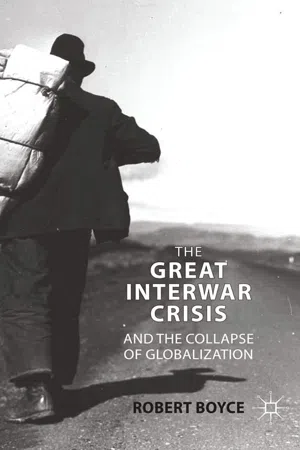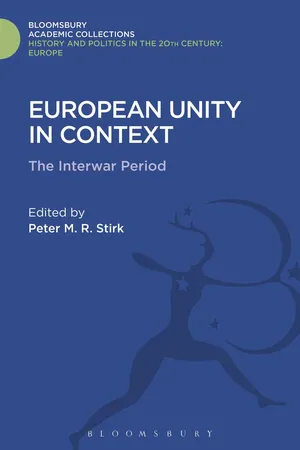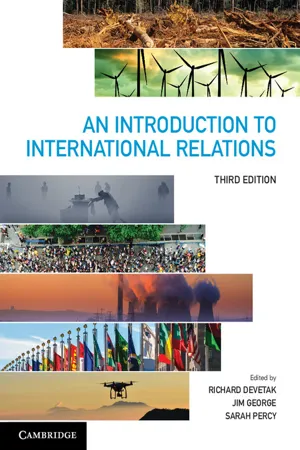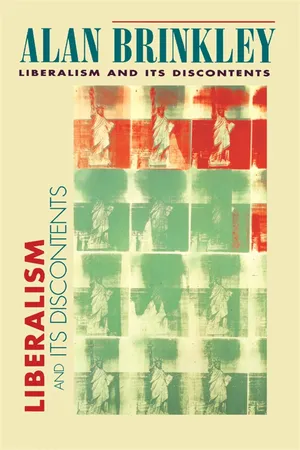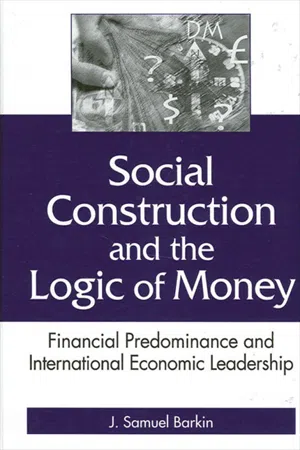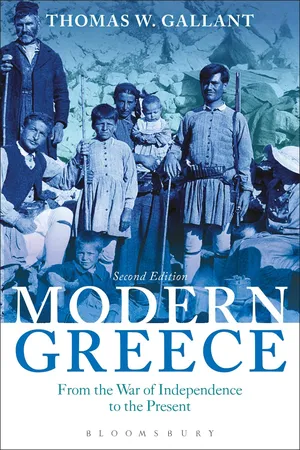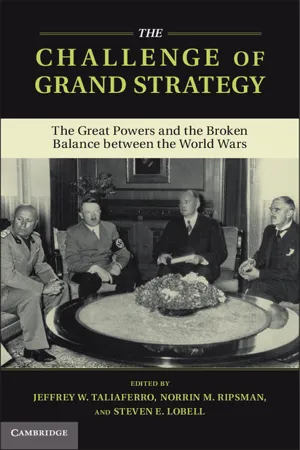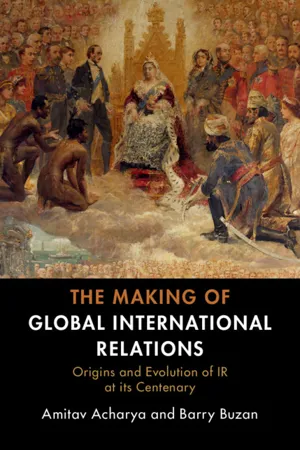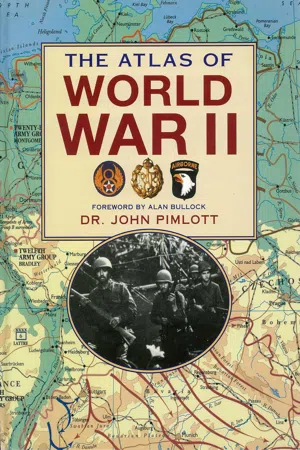History
Interwar Period
The Interwar Period refers to the time between the end of World War I in 1918 and the beginning of World War II in 1939. It was characterized by significant political, social, and economic upheaval, as well as the rise of totalitarian regimes and the Great Depression. The period also saw the establishment of the League of Nations and the rearmament of several countries.
Written by Perlego with AI-assistance
Related key terms
1 of 5
10 Key excerpts on "Interwar Period"
- R. Boyce(Author)
- 2009(Publication Date)
- Palgrave Macmillan(Publisher)
425 8 Conclusion: From the Great Interwar Crisis to the Present 8.1 Towards a new history of the Interwar Period The usual periodization of twentieth-century history treats 1914 as a major turning point, marking the end of the second great era of globalization and the start of an era of upheaval that lasted until 1945. The title of E. H. Carr’s famous study, The Twenty Years’ Crisis, refers to the period 1918–39, but its underlying assumption is that the crisis was bracketed by the two world wars which together formed an uninterrupted period of conflict. This account presents a different way of seeing this epoch and indeed the twentieth century itself. As explained here, the outbreak of war in 1914 brought a collapse of the international states system but only a hiatus in global economic relations. In economic terms the 1920s bore a much closer resemblance to the prewar period than is commonly assumed. Following the war, the three main victor powers broadly agreed on the desirability of restoring a globalized economic system, and largely through their efforts or those of the international sectors of their business communities, states retreated from their wartime directing role, the major currencies were re-linked to one another through the gold standard and markets were reopened. Thus by the second half of the 1920s, world trade and financial flows were greater than before the war and increasing at twice the rate of national growth. The Great War also brought important changes to the international states system, most notably the eclipse of Russia, the expanded role of the United States and constraints upon Germany’s sovereignty from 1918; but for the most part the changes proved to be short-lived. By the mid-1920s, Soviet Russia had practically regained its place as a great power, while the United States had retreated to its prewar status as merely a potential great power.- eBook - PDF
European Unity in Context
The Interwar Period
- Peter M.R. Stirk(Author)
- 2016(Publication Date)
- Bloomsbury Academic(Publisher)
For in a sense this was a period during which the judgement of history enunciated in the First World War, namely the emergence of America as the world power, was temporarily suspended. Europe appeared to have regained or maintained its pivotal role in the world. Vast tracts of the globe seemed like appendages of European states. These states themselves spoke, and occasionally acted, as if the prewar equilibrium could be restored and even improved. Equilibrium was not restored and the end of the period was marked by a war in which an even stronger America allied with the Soviet Union asserted their status as the new superpowers. According to De la Porte, the First World War witnessed another, related, judgement. 6 The European states were no longer capable of restoring any form of stable equilibrium between themselves. Stability could be achieved only by external intervention. To that extent the Interwar Period was precisely that. It was a period in which the old European system stood condemned and was merely waiting for the unpronounced date of execution. It is in fact difficult to find indicators of long-term stability in the wake of the First World War. A new and potentially unstable map was drawn up for Eastern and Central Europe. The Habsburg Empire had disappeared entirely, leaving a truncated core, Austria, whose economic viability was in doubt from the outset and whose political identity was also uncertain. Some sections of the German-speaking population did not intially want an independent Austria at all and called for Anschluss with the German state to the north. The Allies took perverse recognition of this desire when, by the Treaty of St Germain (September 1919), they imposed upon the new state the obligation to preserve its own independence and integrity. Of the various characteristics and motives ascribed to states under the old system self-preservation had always been predominant. - eBook - PDF
- Richard Devetak, Jim George, Sarah Percy(Authors)
- 2017(Publication Date)
- Cambridge University Press(Publisher)
It saw the establishment of new borders for parts of Europe and the region that became the Middle East, giving rise to regional conflicts that persist today. It also saw the emergence of new international organisations, notably the League of Nations, the forefather of the United Nations, which sought to regulate the relations between states in novel ways. In short, the inter-war period provided the foundations for the international system that developed over the following decades. Many of its contours are still visible today. International history and the study of International Relations While offering an overview of some of the most important developments and events of the period between the wars (see Box 9.1 ), the chapter is also informed by the major IR theories and approaches introduced elsewhere in this volume. It demonstrates how the study of IR theory requires a parallel understanding of international history. Although it might seem obvious to state that good IR requires a good understanding of history, international history is not seen by all today as an essential accompaniment to the study of IR. Indeed, it has increasingly been neglected by the search for more parsimonious theoretical explanations and the use of new social science research methods, which sideline history or use historical evidence selectively (Schroeder 1997 ). BOX 9.1: KEY DATES Major events, 1910–45 1910 Norman Angell’s ‘The Great Illusion’ 1914 World War I begins 1917 The United States enters World War I; Russian Revolution 1918 World War I ends 1919 Paris Peace Conference 1920 League of Nations 1922 Washington Conference 1925 Locarno Treaties 1928 Kellogg–Briand Pact - eBook - PDF
- Alan Brinkley(Author)
- 2000(Publication Date)
- Harvard University Press(Publisher)
7 Historians and the Interwar Years Most Americans who lived through the period from the end of World War I to the end of World War II believed they were experiencing events of special historical importance: an unprecedented capitalist ex-pansion; the greatest economic crisis in the nation’s history; a dramatic experiment in political reform; a cataclysmic world conºict; the rise of the United States to unchallenged global preeminence. Contemporar-ies tried constantly to make sense of their turbulent times, and they produced histories of the era even as it continued. Professional histori-ans were scarcely less eager. Less than a decade after the end of the war, a signiªcant body of scholarship on the interwar years had already begun to emerge. The initial volume of Frank Freidel’s monumental biography of Franklin Roosevelt appeared in 1952, as did Eric Goldman’s sweeping (and highly approving) history of twentieth-century liberalism. 1 Three years later Richard Hofstadter published The Age of Reform, which (among other things) attempted to situate the New Deal within a broader reform tradition. 2 In 1956 James MacGregor Burns produced Roosevelt: The Lion and the Fox, an important biography of Roosevelt as president. 3 And in 1957 the ªrst of three volumes of Arthur M. Schlesinger, Jr.’s The Age of Roosevelt appeared, an event that, more than any other, deªned the directions in which future scholarship on the era would move. 4 Schlesinger’s study was notable for its remarkable breadth (it proposed to chronicle the entire Interwar Period) and its exceptional literary grace. But it was notable, too, for its powerful inter-111 pretive stance, a stance that helped shape both popular and scholarly views of the era for at least a generation and that became the basis of much subsequent historiographical debate. - eBook - PDF
Social Construction and the Logic of Money
Financial Predominance and International Economic Leadership
- J. Samuel Barkin(Author)
- 2012(Publication Date)
- SUNY Press(Publisher)
93 5 The Interwar Period and the Great Depression The dynamics of international economic and monetary leadership can be illustrated by examples both of the presence of successful leadership and by its absence. The Great Depression of 1929–1939 represents perhaps the greatest failure of the global economy in the modern era. Its first few years are a classic story of international noncooperation and its potential effects. The period between the two world wars more generally was one of uncertainty in international relations, when lead- ership is needed most. This example is salient to the contemporary international political economy, with its financial implosions and its trade disputes. Now, as then, the international political economy ap- pears to be in transition, and its leadership appears uncertain. 1 The previous two chapters told the stories of countries that acted to varying degrees as international economic leaders. This chapter tells the stories of countries that might have, but did not. Charles Kindleberger speaks of the inability of Great Britain to resume its prewar role of international economic leader, and the unwillingness of the United States to do so. 2 David Lake categorizes France as a “spoiler” throughout the Interwar Period, suggesting that even though it did not have hegemonic capabilities in this period, it played at least a sufficiently important economic role to have a significant impact on issues of leadership of the international economic system. 3 These three coun- tries were also the main players in the German reparations drama, the dominant international financial issue of the 1920s, and the central countries in the three currency blocs that resulted from the collapse of 94 Social Construction and the Logic of Money the international gold standard in the early 1930s. - eBook - PDF
Modern Greece
From the War of Independence to the Present
- Thomas W. Gallant(Author)
- 2016(Publication Date)
- Bloomsbury Academic(Publisher)
8 The inter-war period, 1919–1940: A time of turmoil W ith the cessation of the ‘Great War,’ Greece could have known peace for the first time in years, but it did not. Instead, more war, catastrophic defeat and an enduring legacy of social and political instability would mark the inter-war era in Greece. The combination of the Balkan Wars and the First World War had exacted a heavy toll on Greek society. The key question in 1919 was this: Could Eleftherios Venizelos and the Liberals gain enough from the Allies at the Paris Peace Conference to compensate for the country’s sufferings? At first, it appeared that they had. Soon after the conference, Greece would come as close as it ever would to achieving the dream of the Great Idea. But the dream would soon turn into a nightmare. Military defeat at the hands of the Turkish nationalist forces would all but bring to an end the millennial-long Hellenic presence in Asia Minor. Consequent upon this military debacle would be a decade of social unrest, political chaos and economic disaster. Then Greece, like so many other places in Europe, would fall prey to the sickness of the inter-war period: authoritarianism. Peace and war Prime Minister Eleftherios Venizelos went to the Paris peace talks armed with the vague assurances made to his government by the Allies during the war, all of which focused exclusively on the issue of territorial aggrandizement for Greece. The task before him was daunting and the stakes were high. Internally, political stability hinged on his coming away from the negotiations with a settlement favourable to Greece. As a politician who had risen and stayed in power largely through his successful pursuance of the irredentist MODERN GREECE 190 cause, he had to ensure that the cause of Hellenism in Asia was advanced. Representatives of the Greeks of Asia Minor specifically were lobbying him to ensure that the sufferings visited upon them during the war were recompensed. - eBook - PDF
The Challenge of Grand Strategy
The Great Powers and the Broken Balance between the World Wars
- Jeffrey W. Taliaferro, Norrin M. Ripsman, Steven E. Lobell(Authors)
- 2012(Publication Date)
- Cambridge University Press(Publisher)
12 Conclusions: Rethinking Interwar Grand Strategies David M. Edelstein Scholars of international relations treat few eras of international politics as unproblematically as the Interwar Period. Whereas voluminous debates have ensued over the origins of World War I or the conduct of the Cold War, the Interwar Period has been written off with a relatively simple conventional wisdom: the Treaty of Versailles placed a difficult burden on Germany. This burden, in turn, fomented social unrest in Germany that ultimately propelled the Nationalist Socialist party and Adolf Hitler to power. Subsequently, weak-kneed leaders in Britain and France reacted too cautiously and too slowly to ominous signals of German intentions. False faith in the collective security embodied in the League of Nations only further impaired the type of serious response to Hitler’s Germany that could have prevented World War II. The era of appeasing Germany culminated in the Munich conference – the continuing symbol of the danger of appeasing unappeasable leaders. In this conventional wisdom, the road to World War II begins with the ill-designed settlement to World War I and concludes with the virtually invited German invasion of Poland in September 1939. In the Pacific, meanwhile, the conventional wisdom again focuses on the emergence of a militaristic Japanese state, wholly dependent on foreign sources of energy yet determined to escape that fate. Japan was able to fill a vacuum of strong states in East Asia while capturing the available natural resources along the way. The essays in this volume revisit various aspects of this conventional wisdom. They reopen for investigation the origins of World War II in both Europe and Asia, and they explore how useful contemporary inter- national relations theory is for understanding the period between the wars. In this concluding chapter, I evaluate some of the broader lessons to emerge from the varied analyses contained in this volume. - eBook - PDF
The Making of Global International Relations
Origins and Evolution of IR at its Centenary
- Amitav Acharya, Barry Buzan(Authors)
- 2019(Publication Date)
- Cambridge University Press(Publisher)
67 67 3 The World 1919–1945: Still Version 1.0 Global International Society Introduction The First World War can perhaps best be seen as the first round of a systemic crisis of modernity on a global scale. As we will show in later chapters, subsequent rounds of this crisis (the Second World War, the Cold War and decolonisation, the ‘rise of the rest’) occupied much of the twentieth century. As argued in Chapter 1, the causes of the First World War were generally rooted in the destabilisation of great power relations caused by modernity, and particularly in the destabilisation in military relations caused by both nationalism, and the dynamics of industrial arms racing. The war was not significantly caused by either ideological conflicts about forms of government, or an economic crisis arising out of modernity, though both of those were significant consequences of it. This chapter covers both the interwar years, as a failed attempt to recover and improve on the international society of the core from before 1914, and the Second World War, which was the consequence of that failure. The next section picks up the main themes from Chapter 1, and looks at the continuities with, and discontinuities from, the period before 1914. We argue that the First World War was only a partial crisis of mod- ernity, and that its consequences, though in some ways big, did not fun- damentally change the structure of version 1.0 international society. The following sections look at the main themes of interwar international politics and the Second World War, finding it a much more substantial global crisis than the First. We build towards the argument that the First and Second World Wars and the Cold War, plus decolonisation were not really discrete events, but phases in a more general crisis unfolding from the consequences of the wholesale transformation in international relations generated during the nineteenth century by the revolutions of modernity (Buzan and Lawson, 2015b). - eBook - ePub
- John Pimlott(Author)
- 2022(Publication Date)
- Skyhorse(Publisher)
Adolf Hitler painted by Jacobs.PART I"The Inter-War Period,1919–1939World War I (1914–1918) left a number of legacies. At one level, there was an understandable desire to avoid such a nightmare again, particularly among those European states that had suffered substantial losses in both men and material. This was manifested in calls for disarmament and international cooperation, based on a “new world order” that had at its center the League of Nations, established in 1920. But there was also a steady growth in political extremism, reflecting the enormous social changes triggered by the conflict and the unsatisfactory nature of the peace settlement that emerged between 1919 and 1921. At the same time, the military lessons of the war could not simply be forgotten. The impact of new technology, on land, at sea and especially in the air, altered the way in which force could be used for political ends, offering alternatives to the attritional deadlock of 1914–18 which made that bloodbath seem an aberration. To the optimists, it may have been “the war to end all wars”, but to many it was merely one more step in man’s inexorable journey to Armageddon.These emotions and beliefs became apparent very quickly. In countries such as Britain and France, where the victory of 1918 seemed small recompense for the human losses incurred, war-weariness was shown in calls for rapid demobilization and disarmament. Indeed, the British Army – over three million strong in 1918 – was reduced to pre-war levels and returned to the “proper soldiering” of colonial policing so quickly that much of the hard-won experience of the war years was forgotten. Moreover, as the peacetime period progressed, the desire to avoid a repetition of the recent conflict did not diminish. Memoirs of the war abounded, many of them stressing the suffering, hardship and waste involved, while the new medium of film portrayed the reality of trench deadlock to the next generation. To the survivors of 1914–18, there was little glory to be found in war. Small wonder, therefore, that when Britain and France entered a new conflict in 1939, they did so not with the jingoism of 1914 but with an air of resigned determination. - eBook - PDF
Commerce and Coalitions
How Trade Affects Domestic Political Alignments
- Ronald Rogowski(Author)
- 2020(Publication Date)
- Princeton University Press(Publisher)
CHAPTER THREE The Interwar Period and the Depression of the 1930s: The Decline and Fall of World Trade CHANGES IN TRADE WORLD WAR I wrote an abrupt and fiery coda to the preceding century's unremitting expansion of trade. The blockades and embargoes of the war directly interrupted commerce; and the consequences of the peace, even if they were less dire than Keynes (1919) had predicted, inhibited any easy revival of trade on its previous scale and intensity. Russia's revolution, civil war, and economic dislocation long excluded it as a source or a market in anything like its previous extent: Russian grain exports, which had peaked at nearly 13 million metric tons in 1910, never exceeded 2.6 million in the 1920s. 1 Shifts of boundaries separated factories from their accustomed re-sources and outlets. The successor states of eastern and southeastern Eu-rope, out of insecurity and a desire for autarky, imposed absurd barriers to trade on once-vital European transit routes. 2 The unequal inflations of the various belligerents' currencies, during and (even more) after the conflict, burdened international transactions with new insecurities and costs, from which all too often only barter could offer an escape. 3 And protectionism recrudesced powerfully almost everywhere—even, astonishingly, in once devoutly free-trading Britain. 4 For some of the principal trading partners of the old international order, these new obstacles proved insurmountable: even in the relative prosperity of 1928-1929, British exports achieved only 81 percent and German ex-1 Mitchell 1978, table C7, 167. 2 For a time, none of the Austrian successor states was ready to allow its railway rolling stock to cross its borders for fear of seizure, and goods had to be unloaded and reloaded at every frontier station.
Index pages curate the most relevant extracts from our library of academic textbooks. They’ve been created using an in-house natural language model (NLM), each adding context and meaning to key research topics.
